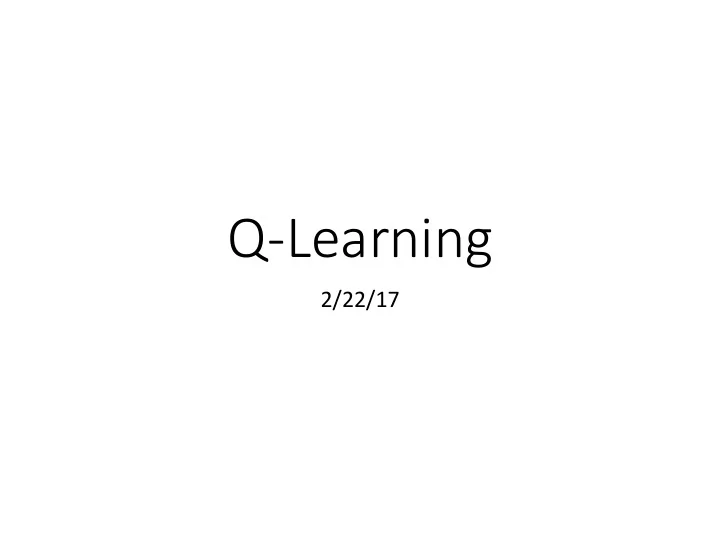

Q-Learning 2/22/17
MDP Examples MDPs model environments where state transitions are affected both by the agent’s action and by external random elements. • Gridworld • Randomness from noisy movement control • PacMan • Randomness from movement of ghosts • Autonomous vehicle path planning • Randomness from controls and dynamic environment • Stock market investing • Randomness from unpredictable price movements
What is value? The value of a state (or action) is the expected sum of discounted future rewards. 𝛿 = discount r t = reward at time t " ∞ # X γ t r t V = E t =0 V ( s ) = R ( s ) + γ max Q ( s, a ) a P ( s 0 | s, a ) V ( s 0 ) X Q ( s, a ) = s 0
VI Pseudocode (again) values = {state : R(state) for each state} until values don’t change: prev = copy of values for each state s: initialize best_EV for each action: EV = 0 for each next state ns: EV += prob * prev[ns] best_EV = max(EV, best_EV) values[s] = R(s) + gamma*best_EV
Optimal Policy from Value Iteration Once we know values, the optimal policy is easy: • Greedily maximize value. • Pick the action with the highest expected value. • We don’t need to think about the future, just the value of states that can be reached in one action. Why does this work? Why don’t we need to consider the future? The state-values already incorporate the future • Sum of discounted future rewards.
What if we don’t know the MDP? • We might not know all the states. • We might not know the transition probabilities. • We might not know the rewards. • The only way to figure it out is to explore. • We now need two things: • A policy to use while exploring. • A way to learn expected values without knowing exact transition probabilities.
Known vs. Unknown MDPs If we know the full MDP: If we don’t know the MDP: • All states and actions • Missing states • Generally know actions • All transition probabilities • Missing transition probabilities • Missing rewards • All rewards Then we need to try out Then we can use value various actions to see what iteration to find an optimal happens. This is called RL: policy before we start acting. Reinforcement Learning .
Temporal Difference (TD) Learning Key idea: Update estimates based on experience, using differences in utilities between successive states. Update rule: V ( s ) = α [ R ( s ) + γ V ( s 0 )] + (1 − α ) V ( s ) Equivalently: V ( s ) += α [ R ( s ) + γ V ( s 0 ) − V ( s )] temporal difference
How the heck does TD learning work? TD learning maintains no model of the environment. • It never learns transition probabilities. Yet TD learning converges to correct value estimates. Why? Consider how values will be modified... • when all values are initially 0. • when s’ has a high value. • when s’ has a low value. • when discount is close to 1. • when discount is close to 0. • over many, many runs.
Q-learning Key idea: TD learning on (state, action) pairs. • Q(s,a) is the expected value of doing action a in state s. • Store Q values in a table; update them incrementally. Update rule: h h ii a 0 Q ( s 0 , a 0 ) Q ( s, a ) = α R ( s ) + γ max + (1 − α ) Q ( s, a ) V(s’) Equivalently: h h i i a 0 Q ( s 0 , a 0 ) Q ( s, a ) += α R ( s ) + γ max − Q ( s, a )
Exercise: carry out Q-learning discount: 0.9 learning rate: 0.2 0 0 0 +1 0 0 0 0 0 0 We’ve already seen the terminal states. 0 0 0 0 0 -1 0 0 0 0 Use these exploration traces: 0 0 (0,0)→(1,0)→(2,0)→(2,1)→(3,1) 0 0 0 0 0 0 0 0 0 0 0 0 (0,0)→(0,1)→(0,2)→(1,2)→(2,2)→(3,2) 0 0 0 0 (0,0)→(0,1)→(0,2)→(1,2)→(2,2)→(2,1)→(3,1) (0,0)→(1,0)→(2,0)→(2,1)→(2,2)→(3,2) (0,0)→(1,0)→(2,0)→(3,0)→(3,1) (0,0)→(0,1)→(0,2)→(1,2)→(2,2)→(3,2)
Optimal Policy from Q-Learning Once we know values, the optimal policy is easy: • Greedily maximize value. • Pick the action with the highest Q-value . • We don’t need to think about the future, just the Q- value of each action . If our value estimates are correct, then this policy is optimal.
Exploration Policy During Q-Learning What policy should we follow while we’re learning (before we have good value estimates)? • We want to explore: try out each action enough times that we have a good estimate of its value. • We want to exploit: we update other Q-values based on the best action, so we want a good estimate of the value of the best action. We need a policy that handles this tradeoff. • One option: ε-greedy
Recommend
More recommend